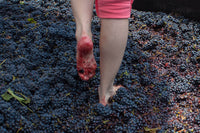
Paleo Wine. Keto Wine. Orange wine. Natural wine. Pet-Nat. Carbonic Maceration. So many trends come and go. Let’s take a look at carbonic maceration to see where it stands. Will this worldwide trend last?
What is Carbonic Maceration?
Made famous with the world-class wines of the Beaujolais wine region in France, carbonic maceration (“CM”) is a production method that makes lively, fruity wines that drink well young.
Beaujolais lies at the southern end of the more famous Burgundy wine region, but the two are distinct, perhaps no more so than in the use of CM.
CM is a form of anaerobic fermentation, a natural process historically, but adapted over time for use in wine and coffee. Anaerobic means oxygen-free. In CM, carbon dioxide (CO2) replaces oxygen.
Burgundy favors traditional wine-making techniques for their elegant and savory Pinot Noir-based wines. The juice from de-stemmed pressed grapes ferments with oxygen exposure and yeasts. There are a few producers in Burgundy using whole-berry fermentation as an alternative.

To clarify fermentation terms:
“whole berry” – traditional yeast fermentation in which winemakers selectively add whole bunches of berries to pressed fermenting must
"whole cluster or whole bunch" – fermentation of full clusters of grapes, including stems
“carbonic maceration” – same as whole cluster and takes place in a closed tank in which carbon dioxide (CO2), which results from fermentation displaces the oxygen in the tank, creating a pressurized system.
Beaujolais winemakers perfected the use of whole cluster and CM to create fresh and fruity Gamay-based wines.
Burgundy wines showcase higher tannins and colors with muted aromas and silky deep-red fruit flavors.
Beaujolais wines display lighter tannins and color, lower acid, and more aromatics, with bright, almost sweet fruit flavors. Gamay produced using CM can reveal cotton candy, bubble gum, or banana-like flavors. The enzymes activated in CM reduce acid levels in the wine.
In traditional fermentation, the grape must (juice from pressed grapes) turns into wine as yeast and oxygen convert grape sugars into alcohol.
In CM, the grape sugars convert to alcohol while the juice remains in the berry. Grapes are not pressed but placed into the tank in full clusters with stems.
Berries at the bottom of the tank burst due to the weight of the other grapes and start yeast fermentation, releasing CO2. Enzymes within the remaining whole berries ferment the juice inside (called intracellular fermentation.)
When the alcohol level reaches around 2%, whole berries burst, and yeast fermentation takes over completing the process.
CM changes the flavors of all wine grapes, but it is mostly used with red varieties because the flavors produced with white varieties were perceived as unappealing. This view seems to be changing.
CM produces wines meant to be drunk young, while the traditional method favors wines for aging.
In France, nouveau wines can also be called “vin de primeur”, “vin jeune,” or « vin de l'année.” Don’t confuse “vin de primeur” with Bordeaux’s “en primeur” selling process.

A Short Bit of History
Historically, most wines underwent CM to some degree. Whole clusters were placed in deep containers that reduced oxygen exposure at the bottom of the vessel.
Rioja winemakers used this method before the influence of Bordeaux. Some still use it to boost aromas and smooth out tannins.
Louis Pasteur experimented with oxygen versus CO2 in wine in the 1870s. Other French scientists conducted trials in the early 1900s.
In the 1960s, Beaujolais négociant, Jules Chauvet, conducted CM studies using the Gamay grape.
The release of Beaujolais Nouveau wines created a sensation. Producersreleased these wines weeks after fermentation finished and the wine bottled. No barrel or bottle aging was required. A good marketing campaign helped propel these less expensive, easy-drinking wines in the market.
The natural wine movement has many proponents of this technique and it has spread throughout the world due to a growing preference toward fresher, lighter wines.
Some winemakers apply only partial CM, and there are various iterations around the world. Vintners are experimenting to reveal the unique expression of each grape variety and terroir.
Grape Varieties and Locations
Nouveau style wines are being made not only from the Gamay variety, but from just about any red grape:
- Bonarda
- Cabernet Franc
- Carignan
- Carménère
- Cinsault
- Grenache
- Malbec
- Merlot
- Pais
- Pinot Noir
- Sangiovese
- Syrah
- Tempranillo
- Valdiguié
- Zinfandel
Some vintners create distinctive white wines with CM from Chardonnay, Gruner Veltliner, Marsanne, Pinot Gris, Riesling, or Trebbiano.
Beyond Beaujolais, other countries and regions around the world embrace CM:
- Argentina: Mendoza, Uco Valley
- Australia: Adelaide Hills, McLaren Vale, South Australia, Yarra Valley
- California: Central Coast, Lodi, Mendocino, Napa, Santa Barbara County, Sonoma, Seiad Valley
- Chile: Cauquenes, Itata, Maule Valley
- France: Burgundy, Cote du Lot, Gaillac, L'Ardeche, Languedoc, Loire, Minervois, Côtes-du-Rhône
- Hungary
- Italy: Umbria
- New Zealand: Central Otago, Hawkes Bay
- Oregon: Willamette Valley
- South Africa: Franschhoek, Paarl
- Spain: Jumilla, Penedes, Rioja/Rioja Alavesa, Terra Alta

Why Carbonic Maceration?
Winemakers and wine drinkers are exploring alternative vinification methods, varieties, and terroirs, resulting in an explosion of diversity. CM is one example.
Reasons winemakers use CM include:
- make more approachable, energetic wines
- highlight freshness, fruitiness, and aromatics
- soften strong tannins
- reduce high acidity
- add elegance and smoother texture
- offset riper fruit coming from hotter regions
- no aging required by either vintner or consumer
- improve cash flow with a faster turnaround
- a shift in consumer preferences away from high-alcohol, heavily extracted wines to lighter, lower alcohol and fruitier wines
- geeky experimentation and geek appeal with sommeliers
- easier to sell at a lower price point
- consumers can drink them right away
- historical process seen as more natural than modern techniques
- because they are fun to make and fun to drink
Controversy surrounds the use of CM. Some say it doesn’t properly express terroir, shows a soda-pop mentality, or the wines are not serious or sophisticated. Some see it as a less-risk averse process.
Sometimes wines can be cloying or too grapey. Like orange wines, those made with CM can be candy-like in flavor, cloudy in the bottle, unbalanced due to little acidity, or exhibit off aromas.
The fun for wine lovers is in comparing different production techniques in the glass. Or in pouring something light and juicy to kick-off the weekend.
Grab a few bottles and make your own decision!

Big Hammer Wines: Your Best Choice
Working with a wine expert is the best way to uncover extraordinary and unusual wines. Big Hammer Wines’ unique business model discovers the best new releases from around the world.
By tasting over 4,500 wines every year, BHW creates an ongoing superior and diversified portfolio of wine that is irresistible.
With an impressive technology-driven direct-to-consumer (DTC) sales model, BHW improves the distribution channel by reducing costs and inefficiencies, passing savings on to customers.
Big Hammer Wines provides consumers with wines of exceptional quality and value at every price point.
Inc. Magazine has recognized BHW as one of the fastest-growing companies in the U.S. Learn more about Big Hammer Wines here.
Big Hammer Wines
The wine experts at Big Hammer Wines taste thousands of wines every year from around the globe, looking for quality and value. This special offer reflects the passion we have for our clients.
Discover the world through its wines, Click Here! Visit Bighammerwines.com and become a wine expert!
Leave a comment (all fields required)
Comments will be approved before showing up.


